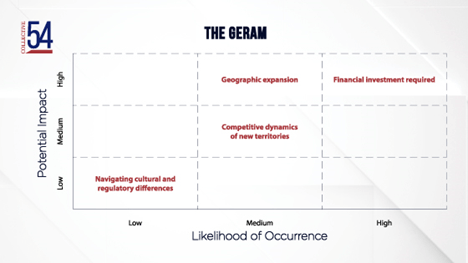Navigating the Risks of Geographic Expansion in Professional Services: A Comprehensive Guide and Risk Assessment Tool
Geographic expansion can be an exciting growth milestone for professional service firms. Symbolizing a prosperous organization with a thriving client base, entering new markets is often seen as an indicator of success. However, it’s crucial to understand that geographic expansion is not a guaranteed path to increased profitability. It carries substantial risks that could potentially destabilize even the most well-established firms.
The primary risk to consider is the substantial financial investment required. Geographic expansion necessitates significant capital for establishing new offices, hiring local professionals, and building a solid market presence. Additional operational costs, such as travel expenses, local taxes, and rent, can put a severe financial strain on firms, especially small to medium-sized ones. Here is an example of a Collective 54 member, Todd Rapp, who took the financial risk of geographic expansion that ultimately led him to re-commit to his hometown clients.
Secondly, navigating cultural and regulatory differences presents a significant challenge. Every region is characterized by unique cultural norms and legal regulations. Misunderstanding these elements can lead to potential reputational damage, legal repercussions, or ineffective service delivery. This risk is especially pertinent for service sectors like law, finance, or consulting, where local knowledge is of utmost importance.
Thirdly, geographic expansion can stretch a firm’s management capabilities to the limit. The task of managing an office in a different city, state, or country demands a new level of leadership and coordination. There’s a risk of diluting the firm’s culture and quality standards, which can negatively impact the brand’s reputation. Here is an example of Collective 54-member, Matt Rosen, who built the management capability to effectively manage distributed geographies.
The final risk revolves around the competitive dynamics of new territories. New markets often mean new competitors who have a deeper understanding of the local market and a loyal customer base. Penetrating these markets can be more challenging and cost-intensive than anticipated.
To navigate these risks, it is essential to conduct a thorough evaluation before deciding to expand geographically. The Geographic Expansion Risk Assessment Matrix (GERAM) is a valuable tool designed to help professional service firms assess the viability of geographic expansion.
GERAM uses a grid system with two factors: ‘Potential Impact’ and ‘Likelihood of Occurrence.’ Each risk is plotted on this grid, providing a clear visual representation of the severity and probability of each risk.
Using the GERAM tool, firms can systematically evaluate each risk associated with geographic expansion, prioritize them, and develop appropriate mitigation strategies. This tool facilitates strategic decision-making, enabling firms to balance the potential rewards against the inherent risks.

In conclusion, while geographic expansion can offer potentially lucrative opportunities for professional service firms, it is not without risks. Before venturing into new territories, firms should carefully weigh the financial implications, cultural and regulatory differences, management capacity, and competitive dynamics. With the aid of the GERAM tool, firms can make informed decisions and strategize effectively for a successful geographic expansion.
